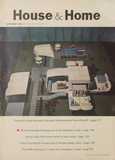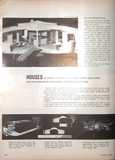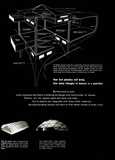


This is the Monsanto House
Architects Marvin Goody and Richard Hamilton designed it for almost 100% use of plastics. Plastic roof and floor sections (sandwiches of reinforced polyester and foamed urethane or styrene insulation) can be stacked (see front cover). plastic foundation (see drawing opposite), plastic wall panels (phenolic paper honeycomb faced with polyester), plastic windows (acrylic in vinyl, styrene or polyester frames), plastic ducts (vinyl or urethane), even plastic columns (reinforced polyester) will be used. Because plastics bend fairly easily without losing their strength, the lightweight, cantilevered structure is overdesigned to get rigidity. If it were just strong enough for its loads, the house would bend and deflect uncomfortably. It swill be built next year in Disneyland, Anaheim, Calif.
House of plastic will have many more colors and curves; Use more standard components, need special jointing
Plastics can be economical only if they are used as plastics, in forms and sizes suited to plastics. They will bring curves back into architecture—partly because they, unlike other materials, are so easy to mold, partly because their easily molded arches are stronger and more economical than beams.
They will be more colorful. Some of their colors will be bright and translucent. Others will be dark—for only acrylics, and some special vinyls and polyesters can stand sunlight, unless ultraviolet rays are screened out with aluminum or carbon black pigments.
They will speed up dimensional standardization, for most plastic parts must be sized at the factory where they arc molded. They need special jointing systems, for changing temperatures make them expand and contract more than any other building materials.
[…]
| Id | 1690 |
|---|---|
| Availability | Free |
| Inserted | 2015-09-01 |